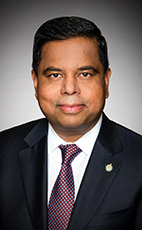Madam Speaker, I rise today to congratulate Girmalla Persaud, executive director of the Malvern Family Resource Centre and a community builder, on her retirement. Girmalla is a friend, mentor and leader. I have had the honour to work with her for over 20 years, and I have witnessed the transformative work that she has undertaken.
Girmalla became the executive director of MFRC 35 years ago, with just two employees and some rented space. Girmalla advocated for MFRC to have its own building, and in 2014 that dream was realized with the completion of a state-of-the-art, 20,000-square-foot space that offers intergenerational programming for toddlers, seniors and everyone in between. She transformed a fledgling organization to one that has over 65 staff and has helped so many turn their lives around.
Girmalla is blessed with an amazing partner, Rohan. She is also blessed with two sons, Robin and Devin, and their partners. I send my thanks to Girmalla for making our community better. I wish her happiness and joy in her retirement as she spends more time with her granddaughters, Nariyah and Savana.

